

Codices. GrazCourtesy of Akademische Druck - u.

Verlagsanstalt - Graz, Austria, we provide here access to their definitive facsimiles of the ancient accordion fold books created hundreds of years ago by Aztec, Maya and Mixtec scribes. LoubatAccess to the duc de Loubat codex facsimilies in conjunction with Universitätsbibliothek Rostock and Bibliothek der Berlin-Brandenburgischen Akademie der Wissenschaften (BBAW), with thanks to Michael Dürr FAMSI project coordinator, Mr.
Rosenau of Mikro-Univers, Ms. Danielewski and Dr. Codices. Now, courtesy of Akademische Druck - u.

Verlagsanstalt - Graz, Austria, FAMSI provides access to their definitive facsimiles of the ancient accordion fold books created hundreds of years ago by Aztec, Maya and Mixtec scribes. Codices: Aztec Group Codex BorbonicusISBN: 3-201-00901-6 Codex IxtlilxochitlISBN: 3-201-00970-9. Les 13 constellations zodiacales mayas. Ces temps-ci, on parle beaucoup de la re-découverte de la 13e constellation dite du Serpentaire par un astronome américain : Voir aussi : L'objet ici n'est pas d'entrer dans la querelle astronomie/astrologie mais de souligner que les « Veilleurs de Ciel » mayas auraient effectivement eu un zodiaque non de 12 mais de 13 « constellations zodiacales » : En effet, le Codex de Paris démontre que les Mayas regroupaient les étoiles du zodiaque en 13 et non 12 constellations. « The third Maya codex that unequivocally contains an astronomical table is the Paris Codex.

This incomplete document includes what appears to be a Maya zodiac. Maya and Aztec creation myths. How did Mesoamericans envision the cosmos? We are honoured and privileged to upload this introductory essay written specially for us by Professor Cecelia Klein, Professor of Art History at UCLA (University of California, Los Angeles).
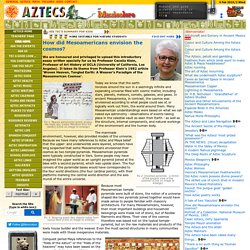
It takes its theme from Professor Klein’s 1982 article ‘Woven Heaven, Tangled Earth: A Weaver’s Paradigm of the Mesoamerican Cosmos’. Today we know that the earth revolves around the sun in a seemingly infinite and expanding universe filled with cosmic matter, including stars, planets, meteors, comets, galaxies, and gases. In ancient Mesoamerica, in contrast, the cosmos was envisioned according to what people could see of, or logically work out from, the world around them. Humanindex: Base de Datos Bibliográfica de Humanidades y Ciencias Sociales. Astronomía. Theudericus : Le Mexique Ancien : Monte Alban.
Monte Albán est un important site archéologique qui a connu son apogée lors de la période Zapotèque entre 200 et 600 après J-C. mais qui aurait été fondé par le peuple Olmèque.
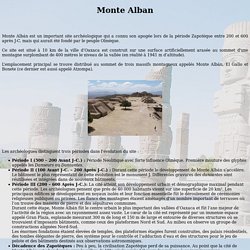
Ce site est situé à 10 km de la ville d’Oaxaca est construit sur une surface artificiellement arasée au sommet d'une montagne surplombant de 400 mètres le niveau de la vallée (en réalité à 1941 m d’altitude). See and Be Seen: (‘Smoking’) Mirrors. The obsidian mirror in the Mexico gallery of the British Museum (right) never fails to fascinate visitors, and the name of the god with which the mirror is commonly associated - Tezcatlipoca - never fails to fascinate those who study the Mexica (Aztecs), for it means ‘Smoking Mirror’.
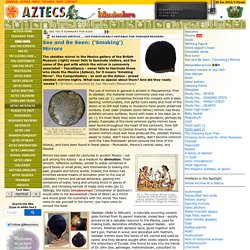
The Conquistadors - as well as the Aztecs - prized obsidian mirrors highly. What was so special about them? And did they really ‘smoke’? (Written/compiled by Ian Mursell/Mexicolore) The use of mirrors in general is ancient in Mesoamerica. Histoire générale des choses de la Nouvelle-Espagne de Frère Bernardino de Sahagún : le Codex de Florence. Livre VII : le Soleil, la Lune et les étoiles, et la ligature ... StarTeach Astronomy Education. Mayan Astronomy Although the Maya appreciated the sky as a whole and its infinite dimensions, they were particularly interested in certain specific astronomical objects.

The sun, the moon, Venus, and specific star clusters and constellations were most important. These objects were given the most attention by the priest-astronomers, who spent generations finding the precise paths of these objects across the sky and through the seasons. The most important object in the sky is the sun, which is universally recognized as the prime life-giver on Earth.
Guatemala Maya textile exhibit offers tactile experience. September 16, 2014 John Daigle Uncategorized Textiles from Guatemala: Traditions and Transitions will be on display at the Center for the Arts Evergreen (Colorado) from September 19 through October 17, 2014.
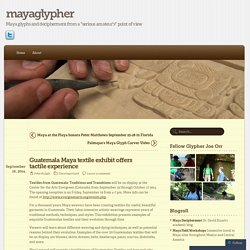
LAL Maya Rubbings at the Houston Museum of Natural Science // Roger Thayer Stone Center For Latin American Studies at Tulane University. Tulane’s Latin American Library has contributed 28 rubbings and images of two Colonial period works to “Maya 2012: Prophecy becomes History” at the Houston Museum of Natural Science.

The exhibit is curated by Tulane alumnus Dr. Dirk van Tuerenhout with the intention of providing a “straightforward chronological overview of Maya culture, past and present.” What do you know about 2012? [Quiz] Educator How-To: Calculating your birthday in Maya Long Count. Adapted from “Cracking the Maya Code,” a NOVA activity.
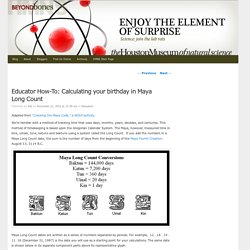
We’re familiar with a method of tracking time that uses days, months, years, decades, and centuries. This method of timekeeping is based upon the Gregorian Calendar System. Jeu Maya multimedia. Post written by FableVisionaries Taryn Johnson, Hannah O'Neal, Jordan Persson Hannah: FableVision Studios was honored to have Commander Chris Hadfield and his lovely wife Helene in the studio last week. Chris Hadfield was the Commander of the International Space Station for expedition 35. Pulsamerica: Impartial, Direct, Independent. Mayan doomsday; Colombia: peace proposal put forward; ‘Count on us for peace, not war’ Mayan doomsday (or not) Throughout 2012 people have been concerned about whether the Mayan Calendar predicts the end of the world on 21 December.
Many websites explain why we should believe in this ‘prophecy’ and advising how to prepare for this date. Dig It Games : Mayan Mysteries. A looter has been digging up Maya sites, clearly looking for something specific. Could it be the mystifying Ladrone, a secretive thief with a history of stealing artifacts? Whoever it is, it’s up to Team Q to stop it! Can you help Professor Alex Quinn and his niece and nephew Fiona and Charlie solve the mystery? Will you be the one who proves worthy of reaching the mythical city of Ich’aak, revealed only to those with pure hearts and the knowledge to protect the artifacts, sites and culture of the Maya?
Texas doomsday exhibit to demystify Maya calendar. The Calendar System. Click on image to view larger The ancient Maya were accomplished observers of the sky. This image shows Maya animal constellations found in the Paris Codex. Using their knowledge of astronomy and mathematics, the ancient Maya developed one of the most accurate calendar systems in human history. Tzolk'in: The Mayan Calendar. Tzolkin: The Mayan Calendar presents a new game mechanism: dynamic worker placement. Players representing different Mayan tribes place their workers on giant connected gears, and as the gears rotate they take the workers to different action spots. During a turn, players can either (a) place one or more workers on the lowest visible spot of the gears or (b) pick up one or more workers. When placing workers, they must pay corn, which is used as a currency in the game.
When they pick up a worker, they perform certain actions depending on the position of the worker. Les géoglyphes de la forêt amazonienne. La forêt amazonienne, l'immense poumon de la planète, objet de toutes les attentions des ONG qui luttent pour la protection de l'environnement et contre le réchauffement climatique est loin d'avoir livré tous ses secrets. Chaque année, malgré la grande colère des écologistes, environ 52 000 km2 de forêt disparaissent. brûlés, défrichés. Une catastrophe qui a permis la découverte d'étranges géoglyphes, Les géoglyphes sont des dessins tracés à même le sols, de très grandes dimensions, et pour cette raison, ils ne sont visibles que vus du ciel. Ou du sommet d'une montage. L'un des plus connu se trouve en Australie: il représente un homme nu, armé d'un bâton.
Les géoglyphes peuvent être tracés en positif ou en négatif. Près de 450 de ces géoglyphes ont été repérés dans la forêt amazonienne, ou plutôt sur les parties défrichées de cette forêt. Relance: et on sait qui a fait ces dessins et de quand ils datent? D'abord on ne sait pas si ce sont vraiment des dessins.
Vous avez tout à fait raison. The Mayan Calendar. El Castillo. 2012 phenomenon: Mayan calendar is only part of rich legacy. Résultats Google Recherche d'images correspondant à. Images Mayan-Calendar.png. The Real Deal: How the Mayan Calendar Works.